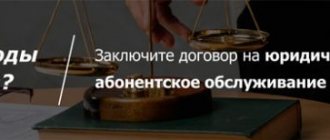Concept for planning on-site tax audits
In order to monitor taxpayers' compliance with the legislation on taxes and fees, the Federal Tax Service authorities are vested with the right to conduct on-site tax audits (ATI).
Making a decision to conduct an on-site tax audit in relation to a certain person does not occur spontaneously and solely at the request of the inspection inspector. This decision is determined by the presence of certain factors and circumstances, the understanding of which will allow you with a high degree of probability to understand whether to expect an inspection soon or not.
The aforementioned Order of the Federal Tax Service of the Russian Federation dated May 30, 2007 No. MM-3-06/ [email protected] , since Appendix 2 contains criteria for self-assessment of risks for taxpayers. We wrote about how to use these criteria in the article “Tax burden by type of activity: the Federal Tax Service is coming to us.”
The Tax Code of the Russian Federation does not establish criteria for selecting taxpayers to conduct on-site tax audits against them.
Therefore, until 2007 Tax authorities, when ordering on-site inspections, were guided by internal documents of the Federal Tax Service of Russia. And taxpayers had no idea on what principles tax officials used to make selections. However, in May 2007, the Federal Tax Service of Russia issued Order No. MM-3-06/ [email protected] (hereinafter referred to as the Order), in which it explained to a wide range of taxpayers the circumstances under which on-site inspections are scheduled.
Now all publicly available information about the criteria and procedure for selecting taxpayers to conduct on-site audits is collected in the Appendices to this Order.
The publicly available criteria for self-assessment of risks are:
1. The tax burden of a given taxpayer is below its average level for business entities in a specific industry (type of economic activity).
Tax burden = the ratio of the amount of taxes paid and the turnover (revenue) of the organization.
For indicators of the tax burden by industry, see Appendix No. 3 to the Order.
2. Reflection in accounting or tax reporting of losses over several tax periods.
Unprofitable activities for 2 or more calendar years.
3. Reflection in tax reporting of significant amounts of tax deductions for a certain period.
The share of deductions for value added tax from the amount of tax accrued from the tax base is equal to or exceeds 89% for a period of 12 months.
4. The growth rate of expenses exceeds the growth rate of income from the sale of goods (works, services).
Growth rate is the ratio of the value of an indicator at a given time to its value for the immediately preceding same time. or to its value for some other similar time, taken as the basis of comparison. The growth rate is measured in relative terms or percentages.
5. Payment of average monthly wages per employee below the average level for the type of economic activity in the constituent entity of the Russian Federation.
Sources of information on the organization (individual entrepreneur):
— information on the average number of employees for the previous calendar year;
- certificates in form 2-NDFL.
6. Repeatedly approaching the maximum value of the indicators established by the Tax Code of the Russian Federation that grant taxpayers the right to apply special tax regimes.
In terms of special tax regimes, the approach (less than 5%) to the maximum value of the indicators established by the Tax Code of the Russian Federation that affect the calculation of tax for taxpayers applying special tax regimes (2 or more times during a calendar year) is taken into account.
7. Reflection by an individual entrepreneur of the amount of expenses as close as possible to the amount of his income received for the calendar year.
For personal income tax. The share of professional tax deductions provided for in Article 221 of the Tax Code of the Russian Federation, declared in the tax returns of individuals registered in the manner established by current legislation and carrying out entrepreneurial activities without forming a legal entity, in the total amount of their income exceeds 83 percent.
8. Construction of financial and economic activities based on concluding agreements with counterparties-resellers or intermediaries (“chains of counterparties”) without reasonable economic or other reasons (business purpose).
Resolution of the Plenum of the Supreme Arbitration Court of the Russian Federation dated October 12, 2006 N 53.
9. Failure by the taxpayer to provide explanations to the notification of the tax authority about the identification of discrepancies in performance indicators.
Absence without objective reasons of the taxpayer’s explanations regarding what was revealed during the desk tax audit.
10. Repeated deregistration and registration with the tax authorities of the taxpayer in connection with a change in location (“migration” between tax authorities).
Two or more cases from the moment of state registration of a legal entity, submission during an on-site tax audit to the registering authority of an Application for state registration of changes made to the constituent documents of the legal entity in terms of changes to information about the address (location) of the legal entity, if these changes entail the need to change the place of registration at the location of the given taxpayer-organization.
11. Significant deviation of the level of profitability according to accounting data from the level of profitability for a given field of activity according to statistics.
Regarding corporate income tax:
deviation (downwards) of profitability according to the taxpayer’s accounting data from the industry average profitability indicator for a similar type of activity according to statistics by 10% or more.
12. Conducting financial and economic activities with high tax risk.
The presence of such signs indicates a high degree of risk of classifying such a counterparty by the tax authorities as problematic (or “fly-by-night”), and transactions made with such a counterparty are questionable.
Thus, the algorithm for selecting taxpayers for tax audits becomes interconnected with the actions of the taxpayers themselves. As soon as the performance indicators of a company or entrepreneur fall under certain criteria, then this taxpayer automatically moves into the “risk zone” of committing tax offenses and, therefore, gets in line for a tax audit. Hence the conclusion: you need to check your organization from time to time for compliance with the Criteria, exclude contacts with problematic suppliers and risk factors such as unreasonable expenses and tax benefits, and promptly contact the tax authorities in case of controversial situations.
Making a decision to conduct a pre-screening analysis (PVA) in relation to a person
One way or another, the Federal Tax Service checks all taxpayers. And the very first filter is to determine the circle of persons in respect of whom the PPA will be carried out.
The selection of taxpayers for conducting an on-site tax audit is carried out by the fiscal authorities on the basis of:
- Order of the Federal Tax Service of Russia dated May 30, 2007 No. MM-3-06/ [email protected] “On approval of the Concept of the planning system for on-site tax audits”, which defines 12 criteria that negatively characterize the taxpayer;
- information regarding a specific taxpayer received from a higher body of the Federal Tax Service (UFTS of Russia for the subject);
- information regarding a specific taxpayer received from other departments of the inspectorate (for example, from the desk tax audit department).
The decision to carry out a PPA in relation to a tax payer is not formalized, it occurs on a routine basis and the payer himself is not informed about it.
Separate units
Situation: can the inspection commission and conduct an independent on-site inspection in a separate division of the organization? The division is neither a branch nor a representative office.
Answer: no, it cannot.
The inspectorate can conduct independent on-site inspections only in branches and representative offices of the organization (paragraph 2, paragraph 7, article 89 of the Tax Code of the Russian Federation). If an organization has one or more separate divisions that do not have the status of a representative office or branch, then the inspectorate does not have the right to appoint and conduct independent on-site inspections of such divisions. Similar explanations are contained in letters of the Ministry of Finance of Russia dated July 31, 2008 No. 03-02-07/1-327 and the Ministry of Taxes of Russia dated February 24, 2004 No. 09-3-02/755. In arbitration practice, there are examples of court decisions that recognize the legitimacy of such a conclusion (see, for example, the decision of the Thirteenth Arbitration Court of Appeal of March 4, 2009 No. A21-5116/2008).
Attention: some courts believe that conducting independent on-site inspections in separate divisions that do not have the status of a branch or representative office does not contradict the law (see, for example, resolutions of the Federal Antimonopoly Service of the North Caucasus District dated August 11, 2008 No. F08-4572/2008 , Northwestern District dated August 10, 2007 No. A42-12847/2005).
Carrying out PPA in relation to a person
If your company eventually comes to the attention of the tax authorities for the reasons described above, this does not mean that an IRR is guaranteed to be carried out against it. Today, the Federal Tax Service is rightfully faced with the task of increasing the efficiency of control in the area of accrual and payment of taxes and fees. This means that before making a decision to conduct a tax return, the fiscal authority must already have preliminary information about potential violations of tax laws by a person, as well as the possibility of actually collecting from him the expected amounts of additional taxes, penalties and fines.
It is for this purpose that a PPA is carried out in relation to taxpayers, within the framework of which the Federal Tax Service authorities use the following tools and sources of information:
- Request information from other government bodies (Federal Customs Service of Russia, Rosimushchestvo, Ministry of Internal Affairs, etc.).
- Requesting information from the taxpayer's counterparties and banks in accordance with Art. 93.1 Tax Code of the Russian Federation.
- Information about the taxpayer from general information sources on the Internet.
- Information about court cases involving taxpayers.
- Some control measures provided for in Ch. 14 of the Tax Code of the Russian Federation (inspection of premises, requesting explanations, etc.).
- Use of specialized information resources of the Federal Tax Service (for example):
- ASK VAT-2 allows you to install the so-called. “tax gap” in the VAT chain;
- PIK "Odnodnevka" - a database of "technical" companies;
- FIR (federal information resource) - database of interrogations, examinations, 2-NDFL certificates;
- PC "VAI" (visual information analyzer) - identifies interdependent persons, sources of their income and other information.
Based on the results of the PPA, a conclusion is issued that reflects the following information:
- The feasibility of conducting a GNP.
- Recommended plan of activities that will need to be carried out within the framework of the GNP.
- Recommendations on the composition of inspectors (including the need to include representatives of law enforcement agencies in their composition).
- The potential amount of additional charges based on the results of the GNP.
- Possibility of actual recovery of additional amounts accrued based on the results of the GNP.
Blog about taxes by Vladimir Turov
Good afternoon, dear colleagues.
Our new Prime Minister, Mikhail Vladimirovich Mishustin, got down to business very energetically and actively. In the next 2-3 years, he will have a direct relationship with any businessman, be it an individual entrepreneur or an organization. And in the near future, everything I say will be relevant to every individual in the Russian Federation. It is in your best interest to read to the end and rejoice in the productivity of our new Prime Minister as he begins to deliver on his promises.
Let's talk about the Order of the Government of the Russian Federation dated February 21, 2020 No. 381-R . With this document, the new Prime Minister approved the concept of the development and functioning of the tax monitoring system in the Russian Federation. In fact, we will get a new era of relations with tax authorities.
What is this concept aimed at?
“This Concept is aimed at improving the quality and efficiency of tax control based on high-tech solutions, simplifying and facilitating interaction between tax authorities and organizations that are taxpayers, payers of fees, payers of insurance premiums and (or) tax agents (hereinafter referred to as payers), increasing the transparency of activities payers."
The main goal of this concept:
- Determine ways and means of digitalization of tax control.
- Subsequent integration of the state control function, corporate information system for taxpayers, which will ensure voluntary, correct and timely calculation of taxes and fees, insurance contributions to the budget system of the Russian Federation.
That is, the goal of this concept is to make sure that tax authorities in real time have direct access not only to your accounting, but in general to all systems of your organization, document flow, and indeed to every penny of yours.
What are the prerequisites for the development of a tax monitoring system?
“The main prerequisites for the development of the tax monitoring system are:
a) the need to maintain a balance of state interests related to ensuring the receipt of taxes, fees and insurance contributions to the budgets of the budget system of the Russian Federation, and the interests of business entities aimed at their own development;
b) the need to reduce the administrative burden by abandoning tax audits and reducing the time frame for carrying out tax control activities;
c) the need to improve information interaction between tax authorities and payers based on the use of modern high-tech solutions;
d) the need for timely identification and analysis of risks in order to prevent violations of the legislation of the Russian Federation on taxes and fees and promptly resolve controversial issues of the correctness of calculation (withholding), completeness and timeliness of payment (transfer) of taxes, fees, insurance premiums;
e) the need for a deep understanding of business models and industry specifics of payers’ activities;
f) the need to reduce the time it takes to detect violations of the legislation of the Russian Federation on taxes and fees in order to increase the preventive effect and prevent these violations;
g) the need to reduce the effect of the “human factor” when conducting tax control;
h) the need to further reduce the number of disputes with payers by developing tools for harmonizing the tax base, the basis for calculating insurance premiums, and objects of taxation;
i) the need to reduce the number of documents (information) submitted to the tax authority on paper and stimulate the transition of payers to electronic document management.”
I compared all these premises and goals with the situation when a special collar is hung on a dog’s neck, and if it runs far from the house, the dog is shocked and returns to the house. The same is planned to be done with taxpayers. And all this, of course, is taking care of us.
What will be the main directions of development of the tax monitoring system?
“Creation of a new system of mandatory requirements for voluntary compliance with the legislation of the Russian Federation on taxes and fees through the integration of tax control into the organizational and information environment of payers with the simultaneous refusal of tax audits, including for the purpose of implementing the instructions to introduce new norms...” That is , when tax authorities integrate into the company’s online environment, they will no longer check it. At the same time, tax officials plan to move to a qualitatively new level of processing documents and information while simultaneously abandoning a complete documentary check, etc.
I would recommend that each of you carefully study this order. Because if your databases are now in cloud storage and when an unexpected check comes to you, you press a button and that’s it, these clouds are cut down. And there is no information on your computers; these are ordinary office computers. Now companies that provide cloud services to protect and secure your data from unexpected arrivals will simply disappear from the face of the earth. If you read the order carefully, you will see that it will be prohibited to store data on cloud services.
Next, tax officials plan to develop “interactive services, open software interfaces and analytical tools that provide automation of tax control through remote launch of an automatic control program in payers’ information systems,” and each of us will be required to provide them with access. This will all be established by federal laws. And of course, conditions will be created to increase the level of trust of tax authorities in taxpayer information systems, as well as in internal control systems.
What will tax officers have access to?
According to clause 8: “in taxpayer information systems to which tax authorities are given access, businessmen will have to provide access to those documents and procedures:
control of the availability of accounting and tax accounting data, transcripts of tax returns, calculations, reports, consolidated and analytical tax accounting registers, accounting, document registers and other documents (information);
automatic generation of indicators of tax returns, calculations, reports, consolidated and analytical registers of tax accounting and accounting, registers of documents, as well as sequential transition (deciphering) of these indicators to an operation (transaction);
control of the availability of links to primary accounting documents, including contracts, with the ability to view (visualize) electronic documents and (or) electronic copies of documents for the purpose of documenting operations (transactions).”
And most importantly, we will have to provide access to every transaction. That is, tax authorities will see our transactions down to every penny. And so on. There is a huge list here, I have only touched on a small part. I talk about these things in detail at the seminar.
How will all this be introduced?
In step No. 1, this will be introduced only for large companies. The taxes of such companies must be at least 300 million rubles, the total turnover must be at least 3 billion rubles, and the value of assets must be at least 3 billion rubles.
“Implementation of the measures provided for in this Concept will ensure:
a) expanding the list of potential participants in tax monitoring:
by 2022 – to at least 3879 payers;
by 2024 – to at least 7827 payers.”
A list of these companies has already been compiled. There must be at least 3879 taxpayers. More is possible, but less is not possible. And then the level of taxpayers who will be included in this system will grow by 20% per year. This means that we can predict that 3 years after the main taxpayers are included in this system, everyone else will be included in it.
At step No. 2, all other legal entities that already fall under the turnover of up to 1 billion rubles will be brought in. And I can easily predict that at step No. 3 individuals and individual entrepreneurs will get into this system.
And a couple more things I want to talk about. “Development of expanded information interaction by organizing access of tax authorities to information systems of payers in real time and moving to a qualitatively new level of document processing...” This will include the development and approval of requirements for identifying participants in information interaction. There is a lot more written here, for example, we will be identified by biometric information, including biometric identification, cloud-based qualified electronic signature, digital citizen profiles, etc.
Thus, writes Mishustin, a trust space for electronic signatures will be created on the basis of a unified identification and authentication system. This is one of the ways to fight all kinds of “leftists”. Plus, I have another document, according to which it will be prohibited from one IP address and from IP addresses located abroad to manage the document flow and payments of other persons. Therefore, all this together is quite interesting.
After all this is implemented, some big cyber attack against the state will be enough, and the entire tax system will collapse, because document flow, as such, will no longer exist after some time, do you understand? But I will not draw a conclusion about whether this is good or bad for taxpayers and why it is dangerous. I have given you enough information for you to draw your own conclusions.
Let me repeat once again what will be done:
- The system will be introduced mandatory for almost 4,000 and then for 8,000 taxpayers. Then this system of access to personnel, accounting, and document flow will be implemented for all taxpayers. And then, I predict that this system will be implemented for all individuals.
- Tax authorities will “help” us calculate taxes. And if we do not agree, then, you understand, there will be an appropriate check. But there will be no more on-site inspections. If the taxpayer does not agree with the tax authorities, then the tax authorities, based on the available access, it is explicitly written here, will have the right to make decisions, as if an on-site audit had already taken place.
There is a huge amount of information in the document that you should know and be prepared for. Please express yourself in the comments, do you agree that the state is putting things in order in this area? Is there a danger here of creating a society of digital slaves? Or the dangers, I will say carefully, of the use of all these technologies by the state in its sometimes rather strange selfish political interests? This is what I personally fear. But that's my concern. I'm waiting for your answers. Because forewarned means forearmed.
Good luck in your business, colleagues.
Link to documents:
Order of the Government of the Russian Federation dated February 21, 2020 No. 381-r
SIGN UP FOR A TAX SEMINAR
(Visited 5,658 times, 2 visits today)
Vladimir Turov
Head of legal practice, practicing and leading specialist in tax planning, building individual tax schemes and holdings, optimizing financial flows.
Deadlines
The period for conducting an on-site tax audit (that is, the period during which an on-site audit can be carried out), in accordance with clause 6, paragraph. 5 paragraph 7 art. 89 of the Tax Code of the Russian Federation is:
- 2 months - as a general rule;
- up to 4 or even 6 months - if there are circumstances that allow you to extend the period. They are listed in Appendix No. 4 to the Order of the Federal Tax Service of Russia dated 05/08/2015 No. ММВ-7-2 / [email protected] (for example, such as the presence of separate divisions in the company, force majeure - fires, floods, etc., the emergence of new information about tax violations, etc.);
- up to 1 year, if, in addition to extending the inspection period, decisions are made to suspend it on the grounds specified in clause 9 of Art. 89 Tax Code of the Russian Federation.
Legal documents
- Order of the Federal Tax Service of the Russian Federation dated May 30, 2007 No. MM-3-06/ [email protected]
- Order of the Federal Tax Service of Russia dated May 30, 2007 No. MM-3-06/ [email protected]
- Art. 93.1 Tax Code of the Russian Federation
- Ch. 14 Tax Code of the Russian Federation
- Art. 89 Tax Code of the Russian Federation
- Order of the Federal Tax Service of Russia dated 05/08/2015 No. ММВ-7-2/ [email protected]
Criteria for assigning a tax audit
There are 12 criteria for an on-site tax audit, on the basis of which tax inspectors plan on-site audits. The more matches there are in the parameters, the higher the likelihood of assigning a control measure.
Entrepreneurs and organizations that meet all the criteria are most likely to be included in the plan of on-site audits initiated by the tax service.
Important numerical indicators are the tax burden (criterion 1) and the level of profitability (criterion 11), which are updated every year.
Restrictions on inspections
Tax legislation establishes a number of restrictions on conducting on-site audits. Thus, as a general rule, the tax inspectorate cannot conduct a repeated on-site inspection in an organization (its branch, representative office) (paragraph 1, paragraph 5 and paragraph 3, paragraph 7, article 89 of the Tax Code of the Russian Federation). There are exceptions to this rule. For more information about this, see: In what cases are repeated tax audits carried out?
Another limitation concerns the number of on-site inspections within one calendar year. During the specified period, the inspection can conduct no more than two on-site inspections both in the organization itself (paragraph 2, paragraph 5, article 89 of the Tax Code of the Russian Federation), and in each of its branches or divisions (paragraph 4, paragraph 7, article 89 of the Tax Code of the Russian Federation) ).
When determining the total number of on-site inspections for an organization, independent inspections of branches and representative offices of this organization are not included in the calculation (paragraph 3, paragraph 5, article 89 of the Tax Code of the Russian Federation). For example, if during one calendar year the inspectorate conducted one on-site inspection of the organization as a whole (including an inspection of a branch) and one independent inspection of the branch, then by the end of this year the inspection will be able to conduct another on-site inspection of the organization.
The legislation does not establish an inverse relationship. Therefore, when calculating the number of on-site inspections for a specific branch (representative office), both independent on-site inspections of this branch (representative office) and its inspections as part of a general on-site inspection for the organization are taken into account. And if, for example, a branch of an organization was inspected twice during the year as part of general on-site inspections, the inspectorate will not be able to order another independent inspection of the branch.
The limitation on the number of on-site inspections during one calendar year does not apply to repeated on-site inspections (paragraph 2, paragraph 10 and paragraph 11, article 89 of the Tax Code of the Russian Federation). In addition, in exceptional cases, the head of the Federal Tax Service of Russia may appoint an additional on-site inspection beyond the established limit (paragraph 2, paragraph 5, article 89 of the Tax Code of the Russian Federation). Tax legislation does not specify which cases are considered exceptional.
In addition, tax inspectorates cannot conduct on-site audits for periods that were monitored as part of tax monitoring. The exception is on-site inspections, which are carried out:
- by a higher tax authority in relation to the tax inspectorate that conducted tax monitoring;
- upon early termination of tax monitoring;
- if the organization has not followed the instructions given by the inspectorate as part of tax monitoring;
- if the organization filed an updated declaration for the period that was monitored as part of tax monitoring, and reflected in this declaration a decrease in the amount of tax payable to the budget.
This follows from the provisions of paragraph 5.1 of Article 89 of the Tax Code of the Russian Federation.





